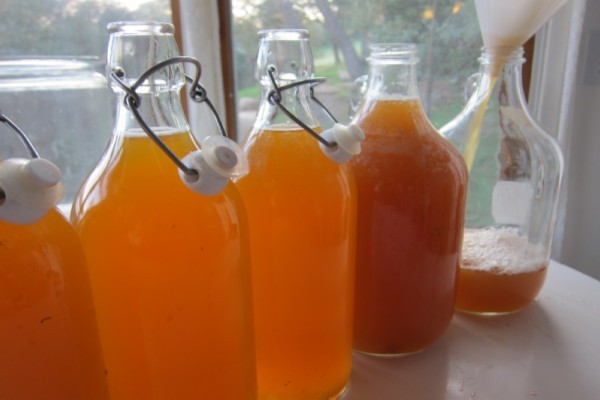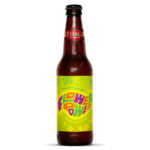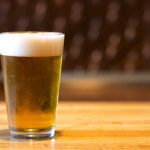Have You Tried Kombucha Brewing at Home?

If your garden is anything like mine, during the mid to late summer months, it’s teeming with fruits and berries. As the calendar turns into the dog days of August, we bring overfull containers inside, piling them on the counter and in the refrigerator while wondering out loud what we can possibly do with it all.
At times, the harvest can be a little overwhelming.
Kombucha brewing is my favorite yearlong, kitchen pass time. The scorching summer months make stovetop beer brewing a burden. One appeal to kombucha is that brewing is inexpensive. All you need is a viable scobie, a generous supply of green tea and sugar, and a few jars for your basic start-up costs. Unlike beer or wine, your upfront investment is nil. Most folks have those things lying around the pantry on any given day (except the scobie, of course).
Another aspect that makes Kombucha so fun is the fertile tea’s relatively short brewing cycle. Primary fermentation requires only seven to ten days, with a secondary cycle of equal length of time. This makes Kombucha an ideal project for rapid flavor experimentation.
Each gallon of Kombucha I split into four quarts for the secondary ferment. After primary fermenting on whole, organic sugar, I flavor the second with fruits and an assortment of herbs. Over the years, I’ve found some fruits difficult (such as oranges, apples, and pineapples) while others I’ve been quite successful with.
WATERMELON
Ripe, juicy watermelon is a summertime staple at our house. We carve it up into cubes and stash it in the fridge for hot night cool offs.
Watermelon is also an excellent secondary ferment, flavoring agent for your Kombucha project. I take a few cubes (cut about the size of a die) and drop them into my quart jar with a teaspoon of priming sugar.
Have an excess of basil too? You’re not stuck making pesto. Throw that in as well. Watermelon Basil Kombucha blend offers a delightfully refreshing flavor.
FIGS
Whoever owned my house before loved their figs. We have two trees in the front and one in the back, giving us an almost season round abundance of green fruit.
I like using figs in Kombucha because the ripe, pulpy inside helps accelerate secondary fermentation. I usually cut figs into quarters and add anywhere from six to ten chunks to my jar with a half-teaspoon of sugar (or less) for priming. I think you’ll find that the figs have enough sugar already, sometimes leading to over vigorous activity. Fig kombucha is one to burp regularly in the jar.
BLACKBERRIES
These are trickier but can be more rewarding than any of the previously fruits. We don’t grow blackberries in our yard, but every alley on our evening dog walk is overrun with thorny treasures.
Blackberries are trickier because there is a narrow window to find the perfect juicy, sweet constitution (and if your neighborhood is like mine, any reachable fruit on the bushes are often picked over already). If I pick a quart of blackberries, I usually have enough to flavor a batch of kombucha. A few berries muddled at the bottom of the jar with a heaping teaspoon are enough to create that right, effervescent combination of fruity sweetness.
HOPS
Did you plant hop vines with an ambitious home brew project in mind, only to find yourself overburdened, or perhaps with some less than flavorful nuggets?
Hops are an outstanding flavoring agent for kombucha. I’m all for random. I like to throw a handful of low-acid hops into a jar with a teaspoon and a half of sugar, and the result is a clear, crisp drink that features a cider like refreshment.
















